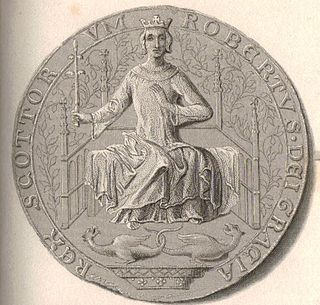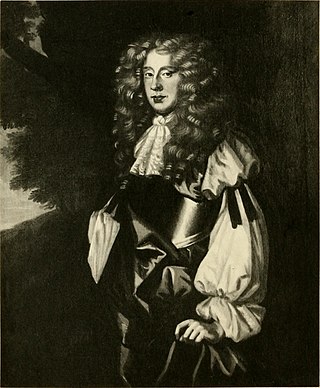Related Research Articles

James I was King of Scots from 1406 until his assassination in 1437. The youngest of three sons, he was born in Dunfermline Abbey to King Robert III and Annabella Drummond. His older brother David, Duke of Rothesay, died under suspicious circumstances during detention by their uncle, Robert, Duke of Albany. James' other brother, Robert, died young. Fears surrounding James's safety grew through the winter of 1405/06 and plans were made to send him to France. In February 1406, James was forced to take refuge in the castle of the Bass Rock in the Firth of Forth after his escort was attacked by supporters of Archibald, 4th Earl of Douglas. He remained at the castle until mid-March, when he boarded a vessel bound for France. On 22 March, English pirates captured the ship and delivered the prince to Henry IV of England. The ailing Robert III died on 4 April and the 11-year-old James, now the uncrowned King of Scots, would not regain his freedom for another eighteen years.

Robert II was King of Scots from 1371 to his death in 1390. The son of Walter Stewart, 6th High Steward of Scotland, and Marjorie, daughter of King Robert the Bruce, he was the first monarch of the House of Stewart. Upon the death of his uncle David II, Robert succeeded to the throne.

The House of Stuart, originally spelled Stewart, was a royal house of Scotland, England, Ireland and later Great Britain. The family name comes from the office of High Steward of Scotland, which had been held by the family progenitor Walter fitz Alan. The name Stewart and variations had become established as a family name by the time of his grandson Walter Stewart. The first monarch of the Stewart line was Robert II, whose male-line descendants were kings and queens in Scotland from 1371, and of England, Ireland and Great Britain from 1603, until 1714. Mary, Queen of Scots (r.1542-1567), was brought up in France where she adopted the French spelling of the name Stuart.

Isabella of Mar was the first wife of Robert Bruce VII, Earl of Carrick. Isabella died before her husband was crowned King of Scotland. She and her husband were the grandparents of Robert II, King of Scotland, founder of the Royal House of Stuart.
David Stewart was heir apparent to the throne of Scotland from 1390 and the first Duke of Rothesay from 1398. He was named after his great-granduncle, David II of Scotland, and also held the titles of Earl of Atholl (1398–1402) and Earl of Carrick (1390–1402). He shares with his uncle and arch-rival, Robert Stewart, first Duke of Albany, the distinction of being first dukes to be created in the Scottish peerage. David never became king. His marriage to Mary Douglas, daughter of Archibald the Grim, the third Earl of Douglas, was without issue.

The Mormaer or Earl of Atholl was the title of the holder of a medieval comital lordship straddling the highland province of Atholl, now in northern Perthshire. Atholl is a special Mormaerdom, because a King of Atholl is reported from the Pictish period. The only other two Pictish kingdoms to be known from contemporary sources are Fortriu and Circinn. Indeed, the early 13th century document known to modern scholars as the de Situ Albanie repeats the claim that Atholl was an ancient Pictish kingdom. In the 11th century, the famous Crínán of Dunkeld may have performed the role of Mormaer.

John Murray, 1st Marquess of Atholl, KT was a leading Scottish royalist and defender of the Stuarts during the English Civil War of the 1640s, until after the rise to power of William and Mary in 1689. He succeeded as 2nd Earl of Atholl on his father's demise in June 1642 and as 3rd Earl of Tullibardine after the death of his first cousin the 2nd Earl in 1670.
Isabella of Atholl was countess or ban-mormaer of Atholl, Scotland, from the death of her father Henry in 1211 until the accession of her son Padraig in 1236–7.

Clan Murray is a Highland Scottish clan. The chief of the Clan Murray holds the title of Duke of Atholl. Their ancestors were the Morays of Bothwell who established the family in Scotland in the 12th century. In the 16th century, descendants of the Morays of Bothwell, the Murrays of Tullibardine, secured the chiefship of the clan and were created Earls of Tullibardine in 1606. The first Earl of Tullibardine married the heiress to the Stewart earldom of Atholl and Atholl therefore became a Murray earldom in 1626. The Murray Earl of Atholl was created Marquess of Atholl in 1676 and in 1703 it became a dukedom. The marquess of Tullibardine title has continued as a subsidiary title, being bestowed on elder sons of the chief until they succeed him as Duke of Atholl.

Walter Stewart, Earl of Atholl, Strathearn and Caithness was a Scottish nobleman, the son of Robert II of Scotland. Stewart advocated for the ransom and return to Scotland of the future king in exile, James I, in 1424. In 1425 he served as a member of the jury of 21 which tried and executed his nephew Murdoch Stewart, 2nd Duke of Albany. Eventually, however, Atholl turned against the King and conspired in his assassination in 1437. He was tried for murder and was executed after three days of torture.

The Battle of Culblean was fought on the 30th of November 1335, during the Second War of Scottish Independence. The Scots, led by Guardian Sir Andrew Murray, achieved victory over an Anglo-Scottish force commanded by David III Strathbogie, titular Earl of Atholl a strong supporter of Edward Balliol.

Clan Stewart (Gaelic: Stiùbhart) is a Scottish Highland and Lowland clan. The clan is recognised by Court of the Lord Lyon; however, it does not have a Clan Chief recognised by the Lord Lyon King of Arms. Because the clan has no chief it can be considered an armigerous clan; however, the Earls of Galloway are now considered to be the principal branch of this clan, and the crest and motto of The Earls of Galloway's arms are used in the Clan Stewart crest badge. The Court of the Lord Lyon recognises two other Stewart/Stuart clans, Clan Stuart of Bute and Clan Stewart of Appin. Clan Stuart of Bute is the only one of the three clans at present which has a recognised chief.
Sir David II Strathbogie was Earl of Atholl, Constable of Scotland, and Chief Warden of Northumberland.

Edward Balliol or Edward de Balliol was a claimant to the Scottish throne during the Second War of Scottish Independence. With English help, he ruled parts of the kingdom from 1332 to 1356.

Sir John Menteith of Ruskie and Knapdale was a Scottish nobleman during the Wars of Scottish Independence. He is known for his capture of Sir William Wallace in 1305 and later joined with King Robert I of Scotland and received large land grants in Knapdale and Kintyre for his service. He is described as "guardian" of the Earldom of Menteith, as his great-nephew Alan II, Earl of Menteith was a minor at the time of the death of Alan I, Earl of Menteith.
Sir Adam de Gordon (1273–1333), lord of Gordon, was a Scottish statesman and soldier.
John Byset the Elder, Lord of the Aird was a Scoto-Norman nobleman who is the progenitor of the Bissett family of the Glens of Antrim in medieval northeastern Ireland, present-day Northern Ireland.
Thomas of Galloway, known in Gaelic sources as Tomás Mac Uchtraigh, was a Gall-Gaidhil prince and adventurer. The son of Lochlann, king of Galloway, Thomas was an active agent of his brother Alan of Galloway as well as the English and Scottish kings. When King John, the English monarch, decided that central and western Ulster were to be added to his dominions, he conscripted Thomas and Alan of Galloway to his aid, offering them much of later counties Antrim, Londonderry and Tyrone as incentive.
Sir Robert Graham of Kinpont was a Scottish landowner, and one of the key conspirators in the assassination of King James I of Scotland in 1437.
Walter Byset, Lord of Aboyne was a Scoto-Norman nobleman.
References
- ↑ Sir David Dalrymple (1776). Annales of Scotland: From the accession of Malcolm III. surnamed Canmore, to the accession of Robert I. Vol. 1. Balfour & Smellie. p. 157., citing Matthew Paris